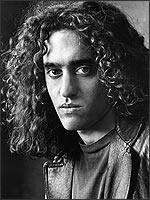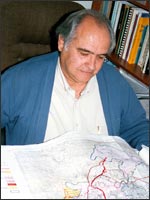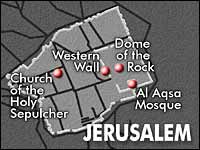Part
I | Part
II | Part
III
Third of three parts
Compiled by Ken George based on the
radio documentary by Michael Goldfarb
 |
Covered body lies on ground after a suicide
bombing, Jerusalem. (AP)
|
In Jerusalem this year, people's radios have brought a steady stream
of bad news: a Jewish woman bewailing the death of her soldier sister
at a bus stop; the screaming of an Israeli Arab woman assaulting the
soldier who shot her child.
The level of tension in the city is profound. It's not just the
current threat of violence, it's the astonishing pace of physical
change in the city's landscape transforming neighborhoods overnight.
Tranquility is no longer a molecule in the air people breathe. So
the city is losing its Israeli population. Most of those who leave
are secular and middle-class - the professional classes. They are
being replaced by Ultra-Orthodox Jews and poor immigrants from Russia.
People look for calm where they can find it. Nathan
Englander drove me to his secret place: an abandoned Arab village
called Lifta. Englander is a one-man demographic: born in America
into a strict orthodox community, he gave up Jewish religious practices
and moved to Jerusalem to write. His first collection of stories,
"For
the Relief of Unbearable Urges" was widely praised in the U.S.
 |
Nathan Englander.
|
To get to Lifta, we took the Begin road, a highway that runs around
Jerusalem and connects the new neighborhoods. Englander pulled off
the highway at a poorly marked turn and stopped the car - below us
the remains of a textbook Mediterranean village were visible. In steep
terraced steps, white houses in little plots of land were nestled
into a horseshoe-shaped valley. "It is one of the most beautiful places
in the world, it's a true Garden of Eden, it is all fruit trees down
there and you can actually hear what you don't hear in Israel and
that is the sound of running water," said Englander.
We started walking down the hill. The sky above was black with
clouds threatening yet more rain. Periodically shafts of light sliced
out between the clouds and raced across the valley.
We poked into one or two houses and saw signs of human habitation.
In the warmer weather Lifta is a haven for hippies, squatters, and
Palestinians who work in Jerusalem and don't have proper papers.
Down the hill we came to a pool fed by a fresh spring. It was
in what would have been the village's central plaza. With a fresh
coat of whitewash, Lifta could have been a film set for a biblical
epic about the shepherd boy named David or the young carpenter called
Jesus. On the hilltops around us were the fortress-like new towns.
But down here in Lifta, it was genuinely peaceful. Unfortunately,
the weather didn't really allow for lingering. So we started back
up the hill, Nathan free-associating his way through his feelings
about the city where he has come to live. "I call it the city of
the preconceived notion. Everyone has their absolutist view of this
place and what it has to be .. people are really threatened by a
different viewpoint...I am just a guy living in Jerusalem because
I like the city and there's gotta be room for that too."
***
This year in Jerusalem the peace process is crumbling, but in
think tanks on both sides of the city people are still planning
for the future.
 |
| Israel Kimche. (Av Harris) |
From helping design the expansion of the city post-1967, Israel
Kimche's team at the Jerusalem Institute has gone on to provide
the demographic and cartographic data as well as the scenarios for
the city's future used by Israeli negotiators during the talks at
Camp David. According to Kimche - a Jerusalem native - "the whole
area should be functioning as one metropolitan area." To illustrate
his point, he pulled out a map of Jerusalem and its environs. Like
a Rorschach blot, one could see various things in it. The first image
is of a 1950's style representation of an atom with Jerusalem as the
nucleus and the Israeli settlements in the West Bank as electrons
hooked up to the city by new roads and tunnels. But the map could
also be seen as an anatomical drawing of the whole region. From the
West Bank towns of Hebron in the South to Ramallah in the north, the
Jerusalem conurbation has a spine of Palestinian neighborhoods with
Jewish West Jerusalem and Jewish settlements to the east where the
lungs would be. The heart, of course, is the Old City. It seems indivisible
- but preserving the region is not Kimche's task at the moment. "I
am working now on various alternatives - one of the alternatives is
separation," he says before pulling out a map showing a Jerusalem
divided between Israeli and a Palestinian control. On the map a main
road runs through the heart of the city. It has around 40 red slashes
in it. If the city were to be divided, this road would cross from
one side's area of control to the other's many times. Each red slash
on Kimche's map represented a crossing point. The planner told me
that there would be a military check point at each one. "I am a Jerusalemite
born, I wouldn't like to continue living in this kind of a city."
he says.
 |
| Map showing the locations of the Holy Sites
within the Old City. (AP) |
For planners in Arab East Jerusalem, the idea of dividing the city
is equally abhorrent. "Jerusalem is a unique city ... and this city
should not be divided again," says Rami Nasrallah of the International
Peace and Cooperation Center. "We need to plan the city in a way that
it will function as one urban unit and we should do it together,"
he says. Nasrallah came to these conclusions via an interesting route.
Also a native Jerusalemite, during the time of the first Intifada
back in the late 1980's, he was an undergraduate at the Palestinian
Al Quds University. Then, the Israeli government closed Palestinian
universities because they were considered hotbeds of radical activity.
Nasrallah applied to college in America. The Israeli government said
he was free to go but he would not be allowed to come back. So he
perfected his Hebrew, stayed home and went to Hebrew University where
he studied under Israel Kimche.
To Nasrallah the future of the city is clear.
 |
| Romi Nasrallah shares his vision for a future
Jerusalem with Michael Goldfarb. (Av Harris) |
"We have to develop the human capital, we have to develop the engines
of the economy of Jerusalem and there is a potential here to develop
Jerusalem as a world city," he says. Nasrallah has published a pamphlet
describing his vision for the city in the year 2020. It is a city
with both its main populations at peace. But that kind of peace seems
a very distant hope. Even Judit Keshet, keeping lonely watch at the
Israeli checkpoint, acknowledges as much, "I think what is really
lacking .. is even a basic element of good will .. both sides I think,
feel they have more to gain through conflict at this moment than by
negotiation."
***
The best place to feel at peace in Jerusalem is to find a rooftop
in the Old City and listen to the sounds of prayer from the many
different houses of worship that trace their beginnings to Abraham's
decision to revere One God and One God only. On a Sunday, rhythmic
chanting from the Coptic Church shares the air with the Muezzin
reading from the Holy Koran and a triumphant ringing of bells.
 |
| Two domes representing two monotheistic religions:
Foreground: The Church of the Holy Seplechre; Background: The
Dome of the Rock. (Av Harris) |
In the Holy Sepulchre, the liturgy of the Orthodox Church shares
space with the liturgy of the Catholic Church. And softest of all,
from down at the Wailing Wall, comes the chaotic sound of Jews praying.
You can easily forget the history of conflict between these faiths
when sitting on a rooftop listening to this sanctified dissonance.
But this year in Jerusalem there is another kind of dissonance.
I came away from the place with a terrible din going on inside my
head. It's the noise when you're having an argument with yourself
and you can hear your own voice and you're imagining the voice of
the person you're arguing with and your can't hear anything anyone
else might be saying to you - even when the other side wants almost
exactly what you do - a Jerusalem united and just, as it was when
Solomon first built the Temple.
<< Part II |
Part I >>
|
 |






